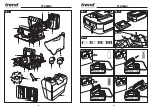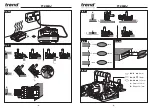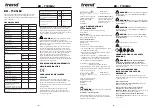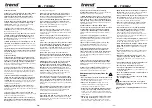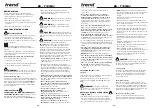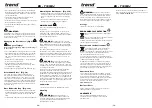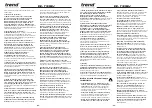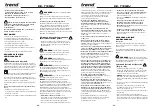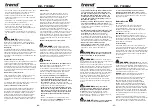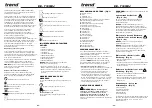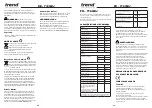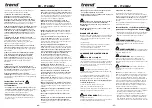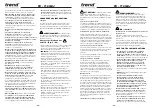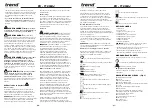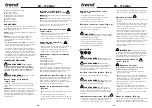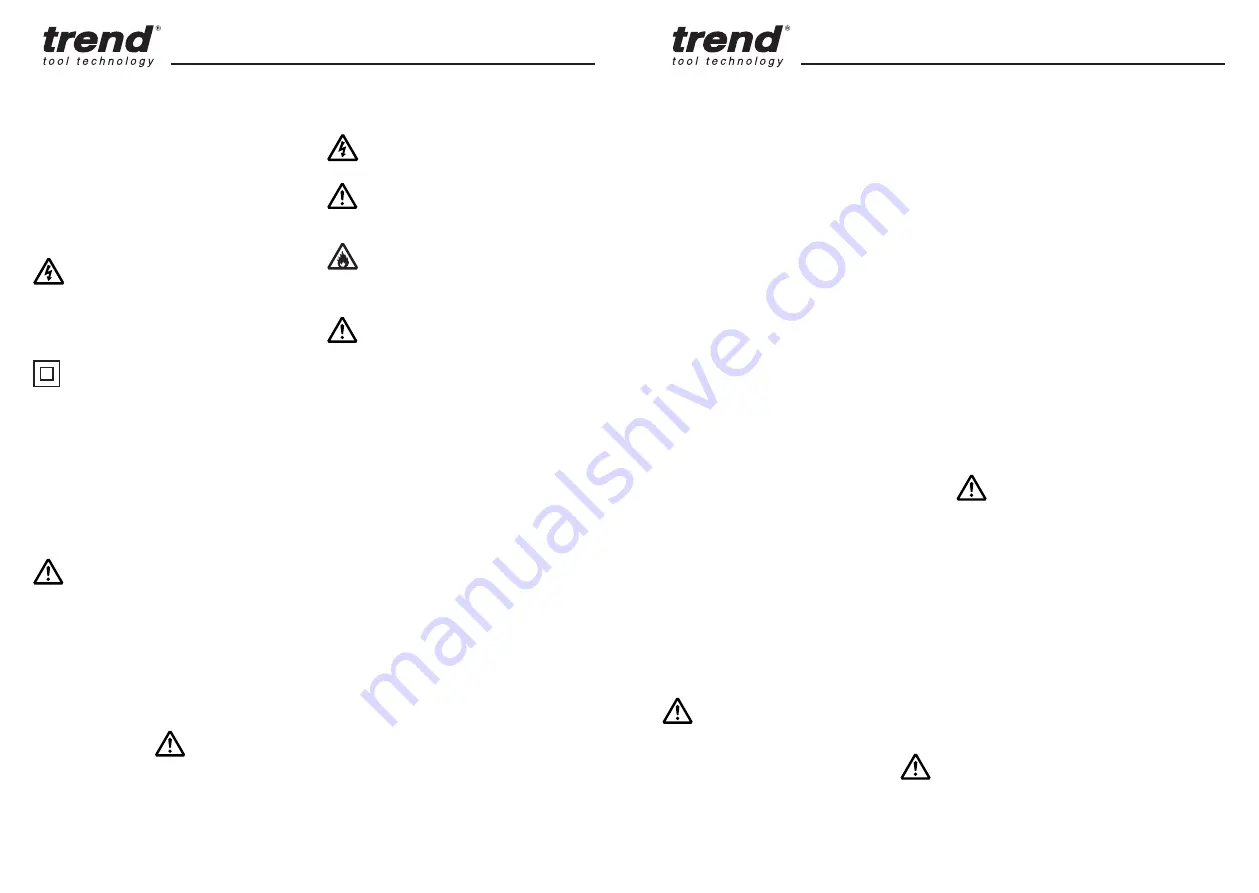
EN - T18S/BJ
EN - T18S/BJ
-13-
-12-
RESIDUAL RISKS
In spite of the application of the relevant safety
regulations and the implementation of safety devices,
certain residual risks cannot be avoided. These are:
• Impairment of hearing.
• Risk of personal injury due to flying particles.
• Risk of burns due to accessories becoming hot during
operation.
• Risk of personal injury due to prolonged use.
SAVE THESE INSTRUCTIONS
Electrical Safety
The electric motor has been designed for one voltage
only. Always check that the battery pack voltage
corresponds to the voltage on the rating plate. Also
make sure that the voltage of your charger corresponds
to that of your mains.
Your Trend charger is double insulated in
accordance with EN60335; therefore no earth wire is
required.
If the supply cord is damaged, it must be replaced by
a specially prepared cord available through the Trend
service organisation.
Mains Plug Replacement (U.K. & Ireland Only)
If a new mains plug needs to be fitted:
• Safely dispose of the old plug.
• Connect the brown lead to the live terminal in the plug.
• Connect the blue lead to the neutral terminal.
WARNING:
No connection is to be made to
the earth terminal.Follow the fitting instructions supplied
with good quality plugs. Recommended fuse: 3A.
Using an Extension Cable
An extension cord should not be used unless absolutely
necessary. Use an approved extension cable suitable for
the power input of your charger (see
Technical Data
).
The minimum conductor size is 1mm
2
; the maximum
length is 30m. When using a cable reel, always unwind
the cable completely.
Important Safety
Instructions for All Battery Chargers
SAVE THESE INSTRUCTIONS:
This manual contains
important safety and operating instructions for
compatible battery chargers (refer to
Technical Data
).
• Before using charger, read all instructions and
cautionary markings on charger, battery pack, and
product using battery pack.
WARNING:
Shock hazard. Do not allow any
liquid to get inside charger. Electric shock may result.
WARNING:
We recommend the use of a
residual current device with a residual current rating of
30mA or less.
CAUTION:
Burn hazard. To reduce the risk
of injury, charge only Trend rechargeable batteries. Other
types of batteries may burst causing personal injury and
damage.
CAUTION:
Children should be supervised to
ensure that they do not play with the appliance.
NOTICE:
Under certain conditions, with the charger
plugged in to the power supply, the charger can be
shorted by foreign material. Foreign materials of a
conductive nature such as, but not limited to, grinding
dust, metal chips, steel wool, aluminum foil, or any
buildup of metallic particles should be kept away from
charger cavities. Always unplug the charger from the
power supply when there is no battery pack in the cavity.
Unplug charger before attempting to clean.
•
Young children and the infirm.
This appliance is not
intended for use by young children or infirm persons
without supervision.
• This product is not intended for use by persons
(including children) suffering from diminished physical,
sensory or mental abilities, or for lack of experience
and/or for want of knowledge or skills unless they are
supervised by a person responsible for their safety.
Children should never be left alone to play with this
product.
•
DO NOT attempt to charge the battery pack with
any chargers other than the ones in this manual.
The charger and battery pack are specifically designed
to work together.
•
These chargers are not intended for any
uses other than charging Trend rechargeable
batteries.
Any other uses may result in risk of fire,
electric shock or electrocution.
•
Do not expose charger to rain or snow.
•
Pull by plug rather than cord when
disconnecting charger.
This will reduce risk of
damage to electric plug and cord.
•
Make sure that cord is located so that it will
not be stepped on, tripped over, or otherwise
subjected to damage or stress.
•
Do not use an extension cord unless it is
absolutely necessary.
Use of improper extension
cord could result in risk of fire,electric shock, or
electrocution
•
Do not place any object on top of charger
or place the charger on a soft surface that
might block the ventilation slots and result in
excessive internal heat.
Place the charger in a
position away from any heat source. The charger is
ventilated through slots in the top and the bottom of
the housing.
•
Do not operate charger with damaged cord or
plug
— have them replaced immediately.
•
Do not operate charger if it has received a sharp
blow, been dropped, or otherwise damaged in
any way.
Take it to an authorised service centre.
•
Do not disassemble charger; take it to an
authorised service centre when service or repair
is required.
Incorrect reassembly may result in a risk
of electric shock, electrocution or fire.
• In case of damaged power supply cord the supply cord
must be replaced immediately by the manufacturer, its
service agent or similar qualified person to prevent any
hazard.
•
Disconnect the charger from the outlet before
attempting any cleaning. This will reduce the
risk of electric shock.
Removing the battery pack
will not reduce this risk.
•
NEVER
attempt to connect 2 chargers together.
•
The charger is designed to operate on standard
230V household electrical power. Do not attempt
to use it on any other voltage.
This does not apply
to the vehicular charger.
•
Take care to ensure that the charger is standing
in a steady, secure position.
A falling battery or
charger may present a risk of injury to yourself and/
or others.
SAVE THESE INSTRUCTIONS
Chargers
Trend chargers require no adjustment and are designed
to be as easy as possible to operate.
The T18S/CH6A charger accepts 18V Li-Ion Trend
battery packs (T18S/BA2A, T18S/BA4AM and T18S/
BA5A).
WARNING:
Only charge in compatible
18V chargers. Use of other chargers may result in fire,
damage or serious personal injury.
Charging a Battery and Operation
- (Fig. 4 – 4d)
• The battery pack for this tool has been shipped in a
low charge condition to prevent possible problems.
Therefore, you should charge it until the green LED on
the front right hand side of the charger comes on.
•
NOTE:
Batteries will not reach full charge the first
time they are charged. Allow several cycles (operation
followed by recharging) for them to become fully
charged.
• First read the safety instructions then follow the
charging instructions.
• Plug the charger into a standard 230V~50Hz mains
socket outlet, the green LED on the front left hand side
of the charger will illuminate.
• Do not allow the cable to become knotted or kinked.
• Place the battery pack into the charger base. (Note
the battery has raised ribs which allows it to fit into
the charger only one way). Time the charge 32, 48, 54
minutes only.
• The red LED on the front right hand side of the charger
will illuminate to indicate charging is in progress. A
green LED will illuminate when the battery is fully
charged.
• Unplug the charger when not in use and store it in a
suitable storage cabinet.
• Avoid charging your battery in freezing conditions as
charging power will not be sufficient.
• When charging more than one battery pack in
succession allow at least 30 minutes for the charger to
cool down before charging an additional battery.
• Always remove the battery pack and store it safely
when the tool is not in use.
CAUTION:
If at any point during the charging
process none of the LEDs are lit, remove the battery
pack from the charger to avoid damaging the product.
DO NOT insert another battery.
Cooling System
The charger is equipped with an internal fan designed
to cool the charger. Never operate the charger if the
fan does not operate properly or if ventilation slots are
blocked. Do not permit foreign objects to enter the
interior of the charger.
Hot/cold Pack Delay
When the charger detects a battery pack that is too
hot or too cold, it automatically starts a Hot/Cold Pack
Delay, suspending charging until the battery pack has
reached an appropriate temperature. The charger then
automatically switches to the pack charging mode. This
feature ensures maximum battery pack life.
Electronic Protection system
Trend Li-Ion tools are designed with an Electronic
Protection System that will protect the battery pack
against overloading, overheating or deep discharge.


